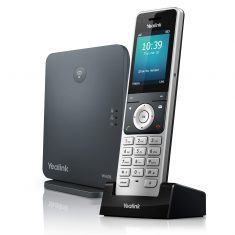Business Phone Systems 101
Glossary to Aid the Buying Process
What’s the difference between SIP and VoIP phones? See 5th point below. Use these terms to help the buying process.
Glossary of Terms
Protocol — A basis for understanding industry terms like VoIP (Voice over Internet Protocol) or SIP (Session Initiation Protocol). Protocols are shared standards for transmitting data packets among telephones, PCs, devices. Devices must receive and send data under the same standards.
SIP — Session Initiation Protocol is known as a “signaling standard.” This protocol initiates “sessions,” or multi-media communications experiences over a SIP phone. These sessions can involve video, chat, data and voice calls. SIP controls phone functions like ring, hold, transfer, conference, etc.
VoIP — Voice over Internet Protocol is an umbrella term for many types of protocol technologies, including SIP. These technologies deliver voice sessions over Internet Protocol (IP) networks by converting analog voice signals into packets of digitized data.
RTP — Real-time Transport Protocol is a standard for delivering audio and video over Internet Protocol (IP) networks in real time.
SIP vs. VoIP Phones — This is not an apples-to-apples comparison. SIP phones operate over VoIP to carry multi-formatted communications such as video, data, chat and voice. These phones should be thought of as being VoIP with SIP. Today, most cloud- hosted telephone systems use VoIP-with-SIP handsets. VoIP-only phones use the Internet and allow voice-only communications. VoIP sets without SIP standards (such as some older models) will not work in a cloud-hosted environment since they do not have Real-time Transport Protocol (RTP).
PBX — An older industry term that means private branch exchange. It refers to an organization’s onsite telephone exchange and equipment.
Trunk lines — These lines connect the PBX to an external public switch telephone network.
SIP trunking — This service uses VoIP to connect premise-based telephones to the internet. A broadband or internet connection replaces traditional lines. SIP trunking can be used with just about any PBX system, including modern IP-based systems. Sometimes these older systems with PRI need an integrated access device (IAD) to bridge the PRI / T1 to SIP. This makes modern cloud-based communications possible.
Cloud-hosted PBX or Cloud-hosted VoIP — Same as “Cloud Communications,” these terms refer to voice and data communications over the internet. All applications, switching and storage are hosted by a third-party outside the organization or business using the system. No capital expenditure for an in-house PBX system is needed, except for the handsets themselves. Ongoing costs (monthly bills and addition of new handsets) are more predictable versus traditional on-premise systems.
Switching to Hosted Phone Systems
Studies show more businesses, especially smaller to mid-sized firms, have switched to hosted over recent years. Primary reasons include monthly savings with cost certainty, modern communications, flexibility with mobility, working remotely and future-proofing their systems. They eliminate capital or maintenance expenditures for in-house equipment as well, except for the handsets.
Before you purchase your next phone system, ask questions, Google the topic and get a list of telecom providers. We want to be on that list and earn your business, of course. We prioritize data networks for voice quality and program handsets to reflect goals specific to daily call needs. To make this happen, we prefer an on-site survey to discuss goals and know your organization better. This can benefit government offices serving taxpayers, busy restaurants and large organizations with multiple locations or call-centers.
Smart communication pays — both in telecom and in-person dialogue.




